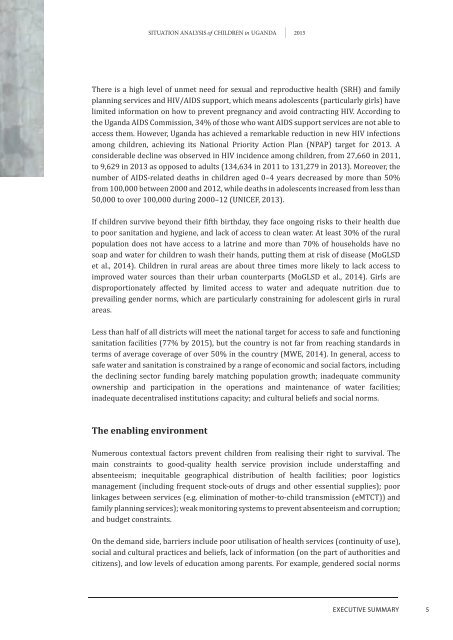Situation analySiS
1TNu802
1TNu802
You also want an ePaper? Increase the reach of your titles
YUMPU automatically turns print PDFs into web optimized ePapers that Google loves.
<strong>Situation</strong> <strong>analySiS</strong> of Children in uganda 2015There is a high level of unmet need for sexual and reproductive health (SRH) and familyplanning services and HIV/AIDS support, which means adolescents (particularly girls) havelimited information on how to prevent pregnancy and avoid contracting HIV. According tothe Uganda AIDS Commission, 34% of those who want AIDS support services are not able toaccess them. However, Uganda has achieved a remarkable reduction in new HIV infectionsamong children, achieving its National Priority Action Plan (NPAP) target for 2013. Aconsiderable decline was observed in HIV incidence among children, from 27,660 in 2011,to 9,629 in 2013 as opposed to adults (134,634 in 2011 to 131,279 in 2013). Moreover, thenumber of AIDS-related deaths in children aged 0–4 years decreased by more than 50%from 100,000 between 2000 and 2012, while deaths in adolescents increased from less than50,000 to over 100,000 during 2000–12 (UNICEF, 2013).If children survive beyond their fifth birthday, they face ongoing risks to their health dueto poor sanitation and hygiene, and lack of access to clean water. At least 30% of the ruralpopulation does not have access to a latrine and more than 70% of households have nosoap and water for children to wash their hands, putting them at risk of disease (MoGLSDet al., 2014). Children in rural areas are about three times more likely to lack access toimproved water sources than their urban counterparts (MoGLSD et al., 2014). Girls aredisproportionately affected by limited access to water and adequate nutrition due toprevailing gender norms, which are particularly constraining for adolescent girls in ruralareas.Less than half of all districts will meet the national target for access to safe and functioningsanitation facilities (77% by 2015), but the country is not far from reaching standards interms of average coverage of over 50% in the country (MWE, 2014). In general, access tosafe water and sanitation is constrained by a range of economic and social factors, includingthe declining sector funding barely matching population growth; inadequate communityownership and participation in the operations and maintenance of water facilities;inadequate decentralised institutions capacity; and cultural beliefs and social norms.The enabling environmentNumerous contextual factors prevent children from realising their right to survival. Themain constraints to good-quality health service provision include understaffing andabsenteeism; inequitable geographical distribution of health facilities; poor logisticsmanagement (including frequent stock-outs of drugs and other essential supplies); poorlinkages between services (e.g. elimination of mother-to-child transmission (eMTCT)) andfamily planning services); weak monitoring systems to prevent absenteeism and corruption;and budget constraints.On the demand side, barriers include poor utilisation of health services (continuity of use),social and cultural practices and beliefs, lack of information (on the part of authorities andcitizens), and low levels of education among parents. For example, gendered social normsExECUtIvE SUMMary5




